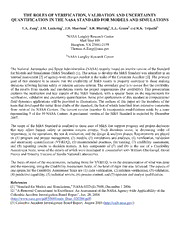
NASA Technical Reports Server (NTRS) 20070017454: The Roles of Verification, Validation and Uncertainty Quantification in the NASA Standard for Models and Simulations PDF
Preview NASA Technical Reports Server (NTRS) 20070017454: The Roles of Verification, Validation and Uncertainty Quantification in the NASA Standard for Models and Simulations
THE ROLES OF VERIFICATION, VALIDATION AND UNCERTAINTY QUANTIFICATION IN THE NASA STANDARD FOR MODELS AND SIMULATIONS T.A. Zanga, J.M. Luckringb, J.H. Morrisonb, S.R. Blattnigb, L.L. Greenb and R.K. Tripathib aNASA Langley Research Center Mail Stop 449 Hampton, VA 23681-2199 [email protected] bNASA Langley Research Center The National Aeronautics and Space Administration (NASA) recently issued an interim version of the Standard for Models and Simulations (M&S Standard) [1]. The action to develop the M&S Standard was identified in an internal assessment [2] of agency-wide changes needed in the wake of the Columbia Accident [3]. The primary goal of this standard is to ensure that the credibility of M&S results is properly conveyed to those making decisions affecting human safety or mission success criteria. The secondary goal is to assure that the credibility of the results from models and simulations meets the project requirements (for credibility). This presentation explains the motivation and key aspects of the M&S Standard, with a special focus on the requirements for verification, validation and uncertainty quantification. Some pilot applications of this standard to computational fluid dynamics applications will be provided as illustrations. The authors of this paper are the members of the team that developed the initial three drafts of the standard, the last of which benefited from extensive comments from most of the NASA Centers. The current version (number 4) incorporates modifications made by a team representing 9 of the 10 NASA Centers. A permanent version of the M&S Standard is expected by December 2007. The scope of the M&S Standard is confined to those uses of M&S that support program and project decisions that may affect human safety or mission success criteria. Such decisions occur, in decreasing order of importance, in the operations, the test & evaluation, and the design & analysis phases. Requirements are placed on (1) program and project management, (2) models, (3) simulations and analyses, (4) verification, validation and uncertainty quantification (VV&UQ), (5) recommended practices, (6) training, (7) credibility assessment, and (8) reporting results to decision makers. A key component of (7) and (8) is the use of a Credibility Assessment Scale, some of the details of which were developed in consultation with William Oberkampf, David Peercy and Timothy Trocano of Sandia National Laboratories. The focus of most of the requirements, including those for VV&UQ, is on the documentation of what was done and the reporting, using the Credibility Assessment Scale, of the level of rigor that was followed. The aspects of one option for the Credibilty Assessment Scale are (1) code verification, (2) solution verification, (3) validation, (4) predictive capability, (5) technical review, (6) process control, and (7) operator and analyst qualification. References [1] “Standard for Models and Simulations,” NASA-STD-(I)-7009, December 1 2006. [2] “A Renewed Commitment to Excellence: An Assessment of the NASA Agency-wide Applicability of the Columbia Accident Investigation Board Report”, Jan. 28, 2004 (http://www.nasa.gov/pdf/55691main_Diaz_020204.pdf) [3] Columbia Accident Investigation Board Report, August 2003 (http://caib.nasa.gov/)
